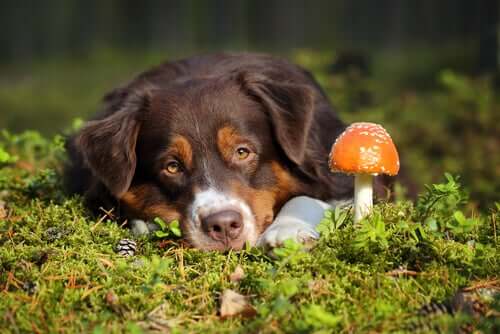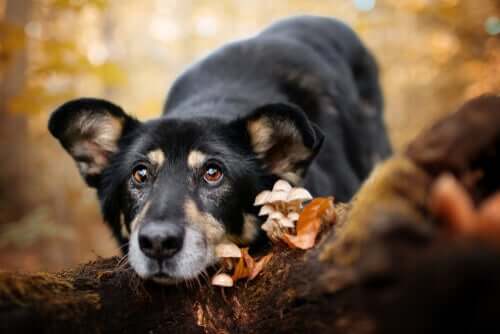Fungus Poisoning in Dogs: What Should I Do?

Fungus poisoning in dogs can happen whether you’re out in the country or in the home. As a result, it’s very important to pay attention to what your dog eats.
Mycotoxicosis is the set of diseases caused by mycotoxins, which are found in fungus or on a surface, substance, or food that has been contaminated.
Bread and fruit are the foods that are most likely to deteriorate, but dog food, and particularly wet dog food, also pose a risk.
When it comes to dogs ingesting fungus, it’s important to take great care. Although some types are harmless or will only cause light gastrointestinal problems, others can be fatal.
Symptoms of fungus poisoning in dogs
The severity and symptoms will depend on the type of fungus and how much they’ve ingested. However, there are a few general indicators that your dog might be poisoned:
- Muscle tremors, poor coordination, and seizures
- Panting and accelerated heart rate and breathing
- Weakness, dehydration, loss of appetite, and vomiting
- Fever
Poisonous fungi can be classified into five categories depending on the symptoms they cause. Here they are in order of severity:
- Fungi that cause gastrointestinal disorders. These can be Agaricus, Boletus, Entoloma, Lactarius, Scleroderma or Tricholoma. Vomiting, abdominal pain and diarrhea usually appear within two hours of being ingested and disappear on their own within two days.

- Hallucinogenic mushrooms. The main ones are Psilocybe, Panaeolus, Conocybe and Gymnopilus. They affect the central nervous system by stimulating serotonin receptors. Although symptoms usually last less than 48 hours, seizures are possible and can even be fatal.
- Fungi that cause muscarinic reactions. These include Inocybe and Clitocybe. Watering eyes, drooling, vomiting, and diarrhea are the most common symptoms and can last for several days.
- Psychotropic Fungi. Amanita muscaria and Amanita pantherina are particularly significant. They can change your dog’s coordination, breathing and can cause seizures or even death. These reactions will appear between 30 and 90 minutes after ingestion.
- Fungi that cause liver necrosis. These include Amanita phalloides, Galerina, and Lepiota. Symptoms start off as gastrointestinal problems and end in liver failure. Symptoms normally take between 6 and 24 hours to appear, and you should go straight to the vet.
Treatment and prevention
Fungus poisoning in dogs should always be treated by a specialist. Although the initial symptoms will be just gastrointestinal, they can get more complicated in just a few hours. Plus, even if the fungus itself is not highly poisonous, it can cause a lot of damage if your dog has ingested large amounts of it.

Some of the most common ways to get rid of the poison are to induce vomiting, pump the stomach, or feed them activated carbon.
In the case of liver problems, convulsions, or changes in heart rate or breathing, the first steps will be to stabilize their vital signs.
As for aftercare, your vet will possibly prescribe some medication with a specific diet and some rest. The 48 hours after suffering fungal poisoning are the most important, so your dog will need constant attention.
It’s not always easy to prevent poisoning. But you should still take every precaution you can when out in the country, parks or gardens, especially in the fall when it’s more humid.
All cited sources were thoroughly reviewed by our team to ensure their quality, reliability, currency, and validity. The bibliography of this article was considered reliable and of academic or scientific accuracy.
- Hovda, L. (2015). Dvm360. Unfriendly fungi: Five types of mushrooms toxic to pets. Recuperado de http://veterinaryteam.dvm360.com/unfriendly-fungi-five-types-mushrooms-toxic-pets?pageID=4
- PetMD. Mushroom, Mold, Yeast Poisoning in Dogs. (S f). Recuperado de https://www.petmd.com/dog/conditions/neurological/c_dg_fungi_poisoning
- Josef, B., Koinig, L., Hollmann, M., & Razzazi-Fazeli, E. (2008). Mycotoxicoses in pets and the occurrence of mycotoxins in dry dog foods. Bulletin UASVM, 65, 1.
- Manal, M. Z., & Laura, R. (2012). Mycotoxins in animals: Occurrence, effects, prevention and management. Journal of Toxicology and Environmental Health Sciences, 4(1), 13-28.
- Ventura, S., Ruiz, C., Durán, E., Mosquera, M., Bandrés, F., Campos, F., … & Queraltó, J. M. (2015). Amanitinas. Revista Del Laboratorio Clínico, 8(3), 109-126.
